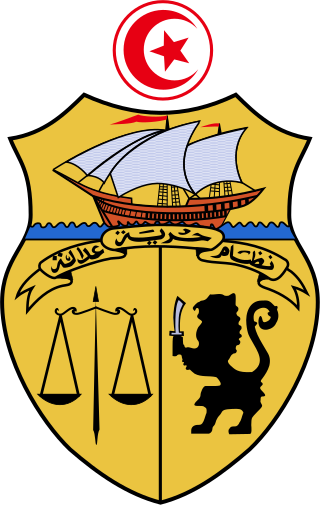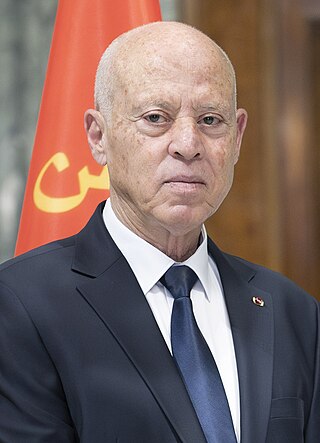
Elections in Egypt are held for the president and a bicameral legislature. The president of Egypt is elected for a six-year term by popular vote after draft amendments to the 2013 constitution altered the presidential term limits from the original four years to six years.

A constitutional referendum was held in France on 21 October 1945. Voters were asked whether they approved of the Assembly elected on the same day serving as a Constituent Assembly, and whether until a new constitution was approved, the country would be governed according to a proposed set of laws that appeared on the ballot paper. If the first proposal had not been approved, the Third Republic would have been restored, but its approval led to the elected Assembly drafting a constitution and proposing it to the people a year later, resulting in the creation of the Fourth Republic. Both were approved by wide margins with a turnout of 79.8%.

A constitutional referendum was held in France on 5 May 1946. Voters were asked whether they approved of a new draft Constitution proposed by the Constituent Assembly elected in 1945.

A constitutional referendum was held in France on 13 October 1946. Voters were asked whether they approved of a new constitution proposed by the Constituent Assembly elected in June. Unlike the May referendum, which saw a previous constitutional proposal rejected, the new Constitution of 27 October 1946 was accepted by 53% of voters, and brought the Fourth Republic into existence. Voter turnout was 68%.
The Constitution of Tunisia is the supreme law of the Tunisian Republic. The constitution is the framework for the organization of the Tunisian government and for the relationship of the federal government with the governorates, citizens, and all people within Tunisia. Tunisia's first modern constitution was the Fundamental Pact of 1857. This was followed by the Constitution of 1861, which was not replaced until after the departure of French administrators in 1956, by the constitution of 1959. It was adopted on 1 June 1959 and amended in 1999 and 2002, after the Tunisian constitutional referendum of 2002.

A constitutional referendum was held in Tunisia on 26 May 2002. The amendments to the constitution would abolish the three-term limit for incumbent presidents and raise the age limit of a sitting president from 70 to 75. A second parliamentary chamber was introduced.
Two referendums were held in Switzerland in 1887. The first was held on 15 May, asking voters whether they approved of a federal law on spirits, and was approved by 65.9% of voters. The second was held on 10 July, asking voters whether they approved of an amendment made to article 64 of the federal constitution, and was approved by 77.9% of voters and 20.5 cantons.
Five referendums were held in Switzerland in 1891. The first was held on 15 March on a federal law on federal officials who had become unemployable due to disability, and was rejected by 79.4% of voters. The second was held on 5 July on a constitutional amendment, and was approved by 60.3% of voters. Two referendums were held on 18 October, one on revising article 39 of the federal constitution and one on a federal law on Swiss tariffs; both were approved. The last was held on 6 December on the question of whether the federal government should purchase the Swiss Central Railway, but was rejected by 68.9% of voters.
Three referendums were held in Switzerland during 1895. The first was held on 3 February on a popular initiative on a federal law on Swiss embassies abroad, and was rejected by a majority of voters. The second was held on 29 September on a federal resolution on amending the constitution regarding the institution of a match monopoly, and was rejected by a majority of voters and cantons. The third was held on 3 November on a constitutional amendment regarding the military, and was also rejected by a majority of voters and cantons.
Three referendums were held in Switzerland during 1897. The first was held on 28 February on a federal law establishing a Central Bank, and was rejected by a majority of voters. The second and third were held on 11 July concerning an amendment to article 24 of the constitution and on legislation on potentially harmful foodstuffs and stimulants. Both were approved by a majority of voters and cantons.
Four referendums were held in Switzerland during 1903. The first was held on 15 March on a federal law on tariffs, and was approved by 59.6% of voters. The second, third and fourth were all held on 25 October concerning an amendment to the federal criminal law, a popular initiative on Swiss residents electing the National Council and an amendment to article 32bis of the constitution. All three were rejected by voters.
A double referendum was held in Switzerland on 15 May 1927. Voters were asked whether they approved of amending article 30 of the constitution and a federal law on car and bicycle traffic. The constitutional amendment was approved by voters, whilst the traffic law was rejected.
Four referendums were held in Switzerland during 1939. The first two were held on 22 January on a popular initiative on civil rights and a federal resolution on the restricted use of the urgency clause in the constitution. The third was held on 4 June on a constitutional amendment regarding the funding for government policies on defence and unemployment, and was approved by voters. The fourth was held on 3 December on a federal law on the employment status and insurance for federal civil servants, and was rejected by voters.
Four referendums were held in Switzerland in 1961. The first two were held on 5 March on an amendment to the constitution regarding oil pipelines and a fuel tax to fund national roads. The constitutional amendment was approved, but the fuel tax rejected. The third referendum was held on 22 October on a popular initiative on using popular initiatives for federal-level laws, and was rejected by voters. The fourth referendum was on a federal resolution on the clock industry, and was approved by two-thirds of voters.
Four referendums were held in Switzerland in 1962. The first was held on 1 April on a popular initiative to ban nuclear weapons, and was rejected by 65% of voters. The second and third were held on 27 May on an amendment to the constitution regarding nature conservation and a federal law amending pay at the federal level. The constitutional amendment was approved, but the law on pay was rejected. The final referendum was held on 4 November on another constitutional amendment on the method of election of the National Council, and was approved by voters.

The Assembly of the Representatives of the People is the lower house of the Parliament of Tunisia. The Assembly replaced the Constituent Assembly and was first elected on 26 October 2014. The legislature consists of 161 seats. Before the 2011 revolution, Tunisia's parliament consisted of an upper chamber called the Chamber of Advisors and a lower chamber called the Chamber of Deputies.

A constitutional referendum was held in Tunisia on 21 October 1945 as part of the wider French constitutional referendum. The first question on the new French National Assembly serving as a constituent assembly was approved by 99% of voters, whilst the temporary constitution proposed in the second question was approved by 79% of voters. Both proposals were also approved in the overall vote. Voter turnout was 69.2%.

A constitutional referendum was held in Tunisia on 5 May 1946 as part of the wider French constitutional referendum. The new constitution was rejected by 64% of voters in Tunisia and 53% of voters overall. Voter turnout was 59.2%.

Kais Saied is a Tunisian politician, jurist and retired assistant professor of law currently serving as the seventh president of Tunisia since October 2019. He was president of the Tunisian Association of Constitutional Law from 1995 to 2019.

A constitutional referendum was held in Tunisia on 25 July 2022 by the Independent High Authority for Elections. The referendum was supported by the Tunisian president, Kais Saied, one year into a political crisis that began on 25 July 2021. The referendum was preceded by an electronic consultation regarding the nature of the political system and the method of voting in legislative elections. It was boycotted by many of Tunisia's largest political parties.





